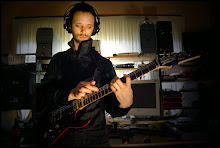Audio Arts – Major Project, Semester 1, 2007
**Audio Arts – Major Project, Semester 1, 2007**
Recording students from Elder Conservatorium is certainly a good way to take the pressure off an EMU session. A direct entry into the space would still be a welcome time saver however. I managed to secure an extra hour and a half of set-up time for the recording session, thanks to someone else’s crew not showing up. This gave me plenty of time to be in ‘plug in an go’ mode, when the band turned up. We started setting up instruments at nine o’clock, so in the back of my mind I knew it was going to be a long night.
Despite the late start, the enthusiasm and energy of the band was in great shape from the outset, and continued until things wrapped up at about two in the morning. Being a funk band comprised of mostly third year Jazz students, these were experienced professional musicians who knew their craft well, and didn’t mess around. It made things easier for me as I could allow them to focus entirely on performance and be left to my own devices regarding micing and signal flow.
There were a few areas that I neglected in the rush. One was spending adequate time micing the kick and snare drums; another was forgetting to bring a roll of masking tape for marking mic leads. With a seven-person band to record, there was a lot of cabling, and as soon as I discovered one problem lead, and subsequently crossed a connection by mistake, I had to mess up my nice neat arrangement under the carpet. I don’t know about anyone else, but I can’t stand the sight of a cable ‘rats nest’. I was also a little slack about the headphone mixes, and had to constantly adjust levels that were probably a little too high for comfort throughout the night.
Despite these niggling issues, the band performed brilliantly in the short space of time, not needing more than six takes as a group to nail any one song. The overdubbed horns on ‘Your loves all gone’ were so tight that I combined three tracks of each of them to create a pseudo big brass section. Notable performers were definitely the ‘ring in’ Shane, on keyboards, who tore up the ivories after being with the band for less than two days! Johns (also a last minute ring in!) saxophone solo on ‘The instrumental’ was also an exquisite moment in time.
Details about the production process in PDF format, along with MP3 files of the final master tracks are available by following the link below.
Click here to link to online folder containing documentation and MP3's.
Reference:
Haines, Christian. ‘Audio Arts – Major Project – Semester 1, 2007.’ Project undertaken at Studio 1 and EMU space Level 5, and Audio lab 408, Level 4, Schultz Building, University of Adelaide, June 2007.
Grice, David. ‘Audio Arts – Major Project – Semester 1, 2007.’ Project undertaken at Studio 1 and EMU space Level 5, and Audio lab 408, Level 4, Schultz Building, University of Adelaide, June 2007.











